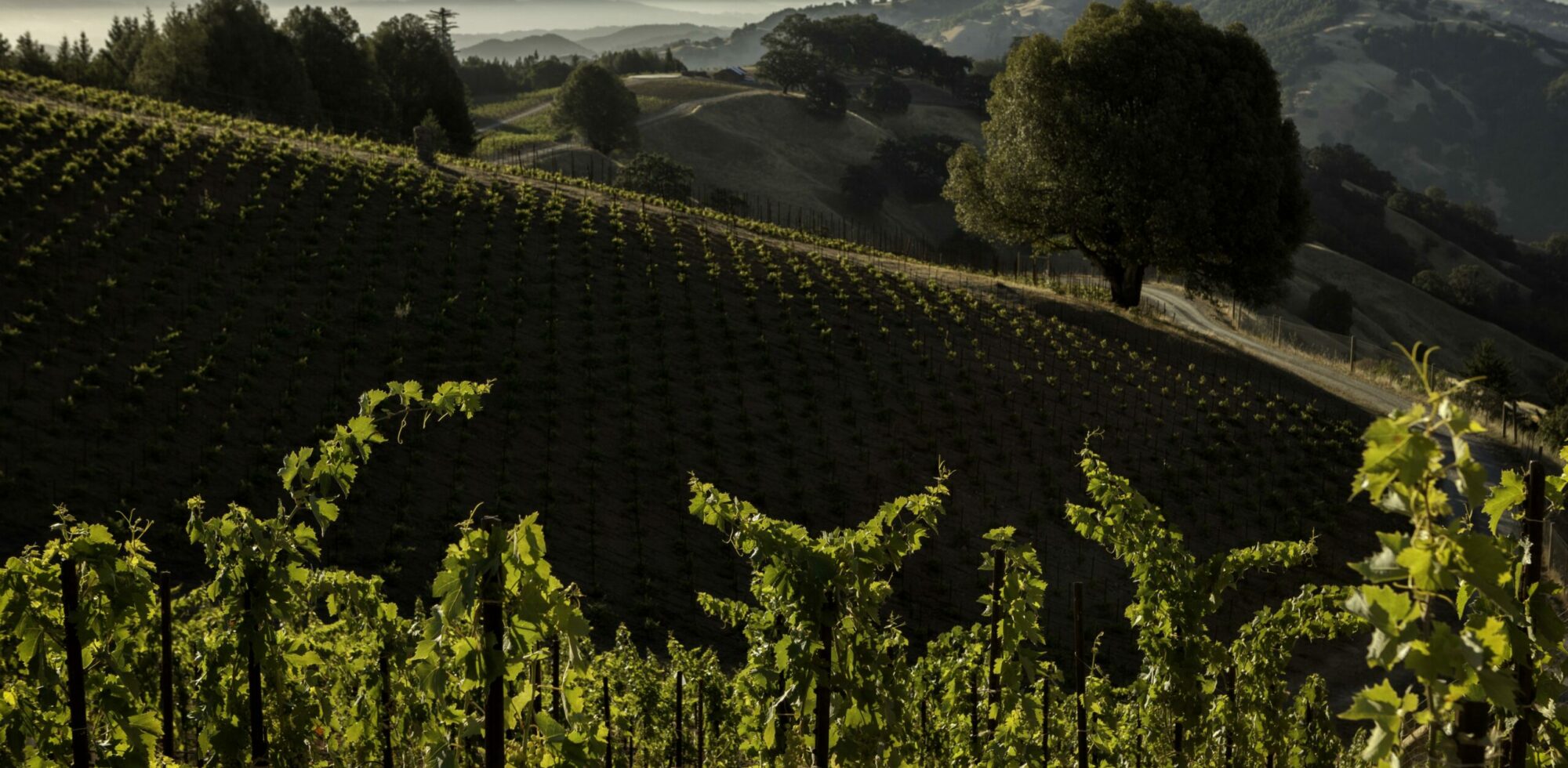Walking on AERIS
Kevin Harvey's Rhys Vineyards develops high in the hills above Dry Creek Valley to make Italian grapes shine.
Photography courtesy of AERIS
Published September/October 2023
- By
- Sarah Bray
- Date:
- November 28 2023

For any Italian wine lover, the grapes nebbiolo, nerello mascalese, and carricante elicit great emotion. They speak of place and let your mind wander to bucket list destinations; they evoke mouthwatering meals; and at their finest, they are transcendent, defying expectations of time and age. However, unlike widely and successfully exported French varieties like cabernet sauvignon and chardonnay, these magical grapes, grown in Piedmont and Mt. Etna respectively, have not been able to find the same success outside of their native environments.
AERIS, a new project from Kevin Harvey of Rhys vineyards, is setting out to change this. Rhys is renowned for their work with pinot noir and chardonnay across diverse soils and marginal climates. But the team shared a love of Italian wines and dreamed of making world-class examples here in California. After a failed attempt at planting nebbiolo in the Santa Cruz mountains, they revised their assumptions. “Really the genesis for all of this was kind of a basic question — why do Italian varieties seem to not perform well outside of Italy,” notes winemaker Jeff Brinkman. This inquiry prompted the Rhys winemaking team to embark on a Quixotic quest to work with these grapes, one that started in Italy and made its way back to Sonoma County.
In the early aughts, Harvey was in Tuscany on vacation and asked for a mineral-driven white wine from the sommelier, who brought out Benanti’s Pietra Marina. This is widely considered to be the benchmark white wine of Mt. Etna, from the carricante grape, and Harvey’s mind was blown. He wrote his team immediately asking if they’d heard of the wine, and they said, Yeah, we just discovered this recently. It was kismet, necessary to then dive deeper. In 2012, a relationship with Salvo Foti, the original winemaker behind Pietra Marina and one of winegrowers who helped put Etna on the map, was formed, and their odyssey began.
Harvey then purchased land on Mt. Etna, becoming the first American to do so, but also began an even more formidable process: importing plant material into the US. Foti selected cuttings from his own vineyards on the volcano and submitted them for testing by UC Davis to make sure that the plants were healthy and virus-free. Only then could they utilize the approved material to propagate a new California vineyard project.
They enlisted the help of Giampiero Romana, an agronomist from Piedmont, and looking at the data, they were stunned to see how warm the Barolo region, home of nebbiolo, which sits in the foothills of the Alps, actually is. The alcohol levels of the wines regularly bear this out; 14.5 percent alcohol is not uncommon for great Barolo. On the other hand, the vineyards on the foothills of Mount Etna, even though that’s located in Sicily in the middle of the Mediterranean, are at elevation, so they’re cooler. Climactically, they kind of meet in the middle – at least that’s what the AERIS team has posited and based their planting decisions on. With Romana, they searched for a place that would encapsulate the factors that they needed to prove their hypothesis, ultimately finding them in in western Sonoma County at what would become the Centennial vineyard.
High in the hills above the Dry Creek Valley, at 2,100 feet above sea level, the site is in a literal no man's land. Driving up and down winding roads snaking around the Lake Sonoma dam, suddenly, you emerge onto this hilltop planted with single-staked vines in the style of the little trees, or alberelli, of Mt. Etna, next to rows of vines of other Italian grapes. Astounding to consider nebbiolo, carricante, and nerello mascalese planted in the same 20-acre parcel, when back in Italy they’re separated by over 800 miles, but the core of AERIS' approach lies in understanding the critical role of climate in the success of Italian grape varieties.
Brinkman has come to believe that the grape has been planted in the wrong conditions, emulating what people think Northern Italy should feel like, rather than looking at what it is: “It was the revelation on why we assumed Italian varieties weren't working, especially in California, where they're being planted in valley floors, where you have these gigantic diurnals, where you can't burn off the acidity. A lot of times you end up stuck with either high sugar, high acid, or both.” When it came to finding the right site, they needed to look for something at elevation, above the fog line, where the nights stay a bit warmer, “where you can lose some of that acidity. And all of a sudden, you can make a balanced wine.” But developing new vineyards are a risky and expensive venture because it takes years from buying land to harvesting fruit. Would the gamble be worth it?
Despite the risk and the huge level of investment, Brinkman says they don’t really see this as a win-lose binary, but rather an ongoing experiment, one that may have particular significance in the context of a changing climate. Italian varieties like carricante are meant for hot weather, fully ripening with refreshing acidity and relatively low alcohols. “It's more of a, can we make it work? Let's see how well we can do with […] making these varieties [taste] varietal, and then potentially having something that might be useful for the industry as a whole going forward. That's cool,” he muses.
Brinkman brought a few bottles of early releases to the vineyard to taste on site. I was more than a bit skeptical, but as we sipped, I was delighted to find the whites showed the characteristic waxiness supporting the fruit intensity of the wines; the nerello was ripe and red-fruited, with a classic grippy, pithy finish; and the nebbiolo was hands-down the best expression of the grape I’ve ever tasted outside of Italy. From anywhere in the world. And Brinkman says the wines going into bottle right now are the best they’ve made to date: “The 21's are so insanely good, head and shoulders above anything we've done. I think it's a combination of vine age finally starting to pay off and just a little bit more knowledge and what we're doing both farming and winemaking, trying to get a handle on it.” It seems the gamble may already be paying off.
Book an appointment to taste the wines of AERIS at their tasting room in Healdsburg.
337 Healdsburg Ave, Healdsburg, CA 95448
[email protected] or phone (669) 240-5611.


